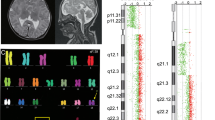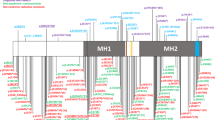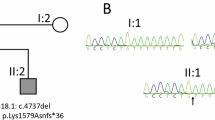Summary
In an attempt to determine the critical monosomic segment involved in 4p- syndrome, we studied the precise breakpoints of five inherited cases with the syndrome using a high-resolution banding technique. The 5 patients ranged in age at diagnosis from newborn to 15 months, 4 of whom could be clinically diagnosed as having 4p- syndrome. Common clinical features included mental retardation, low birth weight, growth failure, hypotonia, microcephaly, peculiar facial dysmorphia and ear malformations. Karyotypes of the 5 were 46,XX,−4,+der(4),t(4;21) (p16.1;q22.3)pat; 46,XX,−4,+der(4), inv ins(4;9)(p15.32p16.3;q34.3)pat; 46,XX,rec(4),del p,inv(4)(p15.2q35)pat; and 46,XX,−4,+der(4),t(4;18) (p15.2;p11.21)mat (two cases, related). The results suggested that monosomy for the proximal half of the 4p16 band is sufficient to express 4p-syndrome.
Similar content being viewed by others
Log in or create a free account to read this content
Gain free access to this article, as well as selected content from this journal and more on nature.com
or
References
Aurias, A., Prieur, M., Dutrillaux, B., and Lejeune, J. 1978. Systematic analysis of 95 reciprocal translocations of autosomes.Hum. Genet. 45: 259–282.
Beutler, E. 1975.Red Cell Metabolism: A Manual of Biochemical Methods, 2nd Ed., Grune Stratton, New York.
Cantú, J.M., Hernandez, A., Nazara, Z., Rolon, R., Ramirez, M.L., Sanchez-Corona, J., and Rivera, H. 1981. Simultaneous trisomy 10q24→qter and monosomy 4p16: an example of epistasis at the chromosome level.Ann. Génét. 24: 41–44.
Centerwall, W.R., Thompson, W.P., Allen, I.E., and Forbes, C.D. 1975. Translocation 4p-syndrome-general review.Am. J. Dis. Child. 129: 366–371.
Chiyo, H., Nakahara, S., Matsumoto, Y., Harada, T., Sakamoto, H., Hashimoto, T., Furuyama, J., and Ohtsuka, N. 1981. A case of translocation 4p- syndrome.Jpn. J. Human Genet. 26: 183–184.
Curry, C.J.R., Ying, K.L., O'Lague, P., and Tsai, J. 1982. Elucidation of the cytogenetic abnormality in a 4p- “phenocopy”.Birth Defects 18 (3B): 275–286.
De Grouchy, J. and Turleau, C. 1977.Atlas des Maladies Chromosomiques, Espansion Scientifique Française, Paris.
Finley, W.H. and Finley, S.C. 1981. Ring 4 chromosome with terminal p and q deletions.Am. J. Dis. Child. 135: 729–731.
Fraisse, J., Lauras, B., Couturier, J., and Freycon, F. 1977. Anneau du chromosome 4. I: avec phenotype 4p-.Ann. Génét. 20: 101–104.
Fryns, J.P., François, B., Timmermans, J., Emmery, L., Speybrouck, J., and van den Berghe, H. 1979. The Wolf-Hirschhorn syndrome.Acta Paediatr. Belg. 32: 135–139.
Hedner, K., Carlsson, E., and Mitelman, F. 1977. Wolf-Hirschhorn syndrome and balanced (4;10) translocation in the father.Clin. Genet. 12: 101–103.
Hirschhorn, K., Cooper, H.L., and Firchein, I.L. 1965. Deletion of short arms of chromosome 4–5 in a child with defects of midline fusion.Hum. Genet. 1: 479–482.
Human Gene Mapping 7. 1984. Los Angeles Conference (1983). Seventh International Workshop on Human Gene Mapping.Cytogenet. Cell Genet. 37: 1.
Ikeuchi, T. and Sasaki, M. 1979. Accumulation of early mitotic cells in ethidium bromide-treated human lymphocytes cultures.Proc. Jpn. Acad. 55: 15–18.
ISCN. 1981. An international system for human cytogenetic nomenclature—high resolution banding.Cytogenet. Cell Genet. 31: 1.
Lejeune, J., Rethoré, M.O., Dutrillaux, B., Lafourcade, J., Cruveiller, J. and Drillon, P. 1975. Syndrome 4p- par translocation paternelle t(4;20)(p15;p12).Lyon Méd. 233: 271–274.
Levy, M., Noel, B., and Viola, D. 1976. Wolf's syndrome in twins—translocation in the mother.Acta Genet. Med. Gemellol. 25: 267–271.
Lurie, I.W., Lazjuk, G.I., Ussova, I., Presman, E.B., and Gurevich, D.B. 1980. The Wolf-Hirschhorn syndrome. I. Genetics.Clin. Genet. 17: 375–385.
Mortimer, J.G., Chewing, W., Miethke, P., and Smith, G.F. 1978. Trisomy 4p and deletion 4p-in a family having a translocation t(4p−;12p+).Hum. Hered. 28: 132–141.
Neu, R., Shott, R.J., and Gardner, L.I. 1975. 4p- phenotype in an infant with t(4p−;19p or q+)mat translocation.Am. J. Dis. Child. 129: 363–365.
Ohdo, S., Ikeda, T., and Ogata, H. 1976. Cytogenetic studies of a case of 4p- syndrome and her mother with balanced translocation, 46,XX,t(2;4)(q37;p14).Acta Med. Univ. Kagoshima 18: 1–8.
Stengel-Rutkowski, S., Warkotsch, A., Schimanek, P., and Stene, J. 1984. Familial Wolf's syndrome with a hidden 4p deletion by translocation of an 8p segment. Unbalanced inheritance from a maternal translocation (4;8)(p15.3;p22). Case report, review and risk estimates.Clin. Genet. 25: 500–521.
Stoll, C., Pennerath, A., and Lausecker, Ch. 1981. 4p- syndrome in a girl with translocation t(1;4) (q11;p16)mat.Hum. Genet. 56: 413–415.
Takata, M., Akamatsu, H., Kashima, M., Shinohara, T., and Takemura, T. 1983. A case of 4p- syndrome with disseminated intravascular coagulation: pathological anatomy.Cong. Anom. (in Japanse)23: 364–365.
Van der Linden, A.G.J.M., Pearson, P.L., and van den Kamp, J.J.P. 1975. Cytological assessment of meiotic exchange in a human male with a pericentric inversion of chromosome No. 4.Cytogenet. Cell Genet. 14: 126–139.
Wilson, M.G., Towner, J.W., Coffin, G.S., Ebbin, A.J., Siris, E., and Brager, P. 1981. Genetic and clinical studies in 13 patients with the Wolf-Hirschhorn syndrome (del 4p).Hum. Genet. 59: 297–307.
Winterbourn, C.C., Hawkins, R.E., Brian, M., and Carrell, R.W. 1975. The estimation of red cell superoxide dismutase activity.J. Lab. Clin. Med. 81: 337–341.
Wolf, U., Reinwein, H., Porsch, R., Schröter, R., and Baitsch, H. 1965. Defizienz an den kurzen Armen eines Chromosomes Nr. 4.Humangenetik 1: 397–413.
Yunis, J.J. 1976. High resolution of human chromosomes.Science 191: 1268–1270.
Author information
Authors and Affiliations
Rights and permissions
About this article
Cite this article
Narahara, K., Himoto, Y., Yokoyama, Y. et al. The critical monosomic segment involved in 4p- syndrome: A high-resolution banding study on five inherited cases. Jap J Human Genet 29, 403–413 (1984). https://doi.org/10.1007/BF01876498
Received:
Published:
Issue date:
DOI: https://doi.org/10.1007/BF01876498
Keywords
This article is cited by
-
Recombinant chromosome 4 in two fetuses - case report and literature review
Molecular Cytogenetics (2018)
-
Recombinant chromosome 4 resulting from a maternal pericentric inversion in two sisters presenting consistent dysmorphic features
European Journal of Pediatrics (2006)
-
Synchronization culture of amniotic fluid cells using excess thymidine block followed by deoxycytidine release and its application to high-resolution banding analysis of chromosomes
Japanese journal of human genetics (1990)



